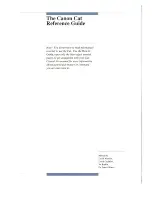
33
Power and signal cables for internal drives
Your computer uses cables to connect integrated drive electronics (IDE) drives to the power
supply and to the system board. The following cables are provided:
•
Four-wire
power cables
connect most drives to the power supply. At the end of these
cables are plastic connectors that attach to different drives; these connectors vary in size.
Also, certain power cables attach to the system board.
•
Flat
signal cables
, also called
ribbon cables
, connect IDE and diskette drives to the system
board.
There are two sizes of ribbon signal cables that come with your computer:
—
The
wider signal cable has two or three connectors.
–
If the cable has three connectors, one of these connectors is attached to the drive,
one is a
spare, and the third is attached to the primary or secondary IDE
connector on the system board.
–
If the cable has two connectors, one of these connectors is attached to the hard
disk drive,
and the other is attached to the primary or secondary IDE connector on
the system board.
Note:
If you want to add another device, and your computer does not come with
a
standard CD-ROM drive or DVD-ROM drive , you will need a second
signal cable with three connectors. You will need an 80-conductor ATA
100 signal cable if you are replacing the existing signal cable or adding a
second hard disk drive. ATA 100 signal cables are color-coded. The blue
connector is attached to the system board, the black connector is
attached to the master device, and the gray middle connector is attached
to the secondary (or slave) device.
If your computer comes with a CD-ROM drive or DVD-ROM drive, it has
an ATA 100 signal cable. However, if you are installing a hard disk drive,
you must change the switch or jumper setting on the CD-ROM drive or
DVD-ROM drive to secondary and change the connector that is used for
the CD-ROM drive or DVD-ROM drive to the gray middle connector.
—
The
narrower signal cable has two connectors for attaching the diskette drive to the
diskette-drive
connector on the system board.
Note:
To locate connectors on the system board, see
“Identifying parts on the system board”
on page 28
.
The following are some important points to remember when connecting power and signal
cables to internal drives:
•
The drives that are standard in your computer come with power and signal cables attached.
If you
replace any drives, it is important to remember which cable is attached to which
drive.
•
When
you install a drive, ensure that the drive connector at the
end
of the signal cable is
always
connected to a drive; also, ensure that the drive connector at the other end is
connected to the system board. This reduces electronic noise from the computer.
•
If two IDE devices are used on a single cable, one must be designated as the primary, or
master,
device and the other as the secondary, or slave, device; otherwise, some of the
IDE devices might not be recognized by the computer. The primary or secondary
designation is determined by switch or jumper settings on each IDE device.
•
If two IDE devices are on a single cable and only one is a hard disk drive, the hard disk
drive must be
set as the master device.
•
If
you have only one IDE device on a cable, it must be set as master.
Installing internal drives
To install an internal drive:
1.
Remove the cover (see
“Removing the cover” on page 25
).
Note:
If your computer has a CD-ROM drive or DVD-ROM drive, you might need to
remove the signal and power cables from the drive.
Содержание NetVista A20i
Страница 1: ......
Страница 4: ...iv Contents ...
Страница 10: ...x About this book ...
Страница 18: ...8 Overview ...
Страница 24: ...14 Installing external options ...
Страница 34: ...24 Installing internal options desktop model ...
Страница 46: ...36 Installing internal options microtower model ...
Страница 52: ...42 Updating the computer configuration ...
Страница 56: ...46 Updating System Programs ...
Страница 62: ...52 Notices and trademarks ...
Страница 65: ......
Страница 66: ...Part Number 22P0801 ...















































